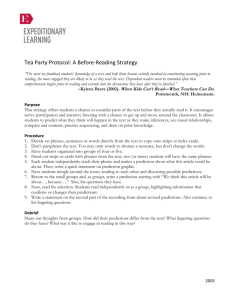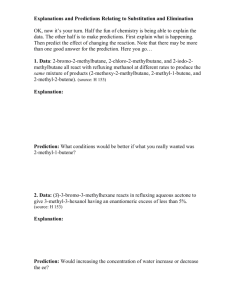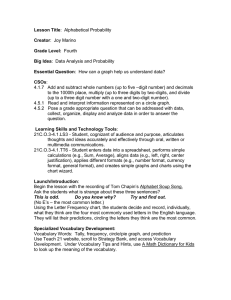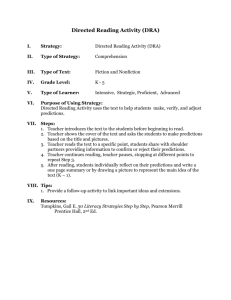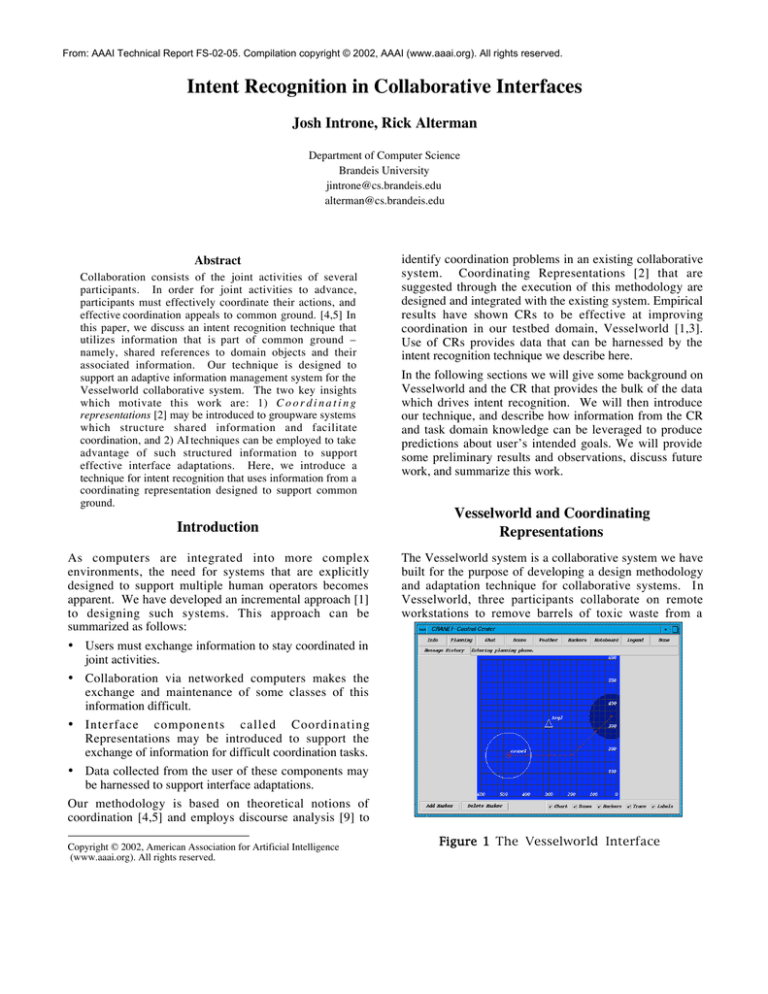
From: AAAI Technical Report FS-02-05. Compilation copyright © 2002, AAAI (www.aaai.org). All rights reserved.
Intent Recognition in Collaborative Interfaces
Josh Introne, Rick Alterman
Department of Computer Science
Brandeis University
jintrone@cs.brandeis.edu
alterman@cs.brandeis.edu
Abstract
Collaboration consists of the joint activities of several
participants. In order for joint activities to advance,
participants must effectively coordinate their actions, and
effective coordination appeals to common ground. [4,5] In
this paper, we discuss an intent recognition technique that
utilizes information that is part of common ground –
namely, shared references to domain objects and their
associated information. Our technique is designed to
support an adaptive information management system for the
Vesselworld collaborative system. The two key insights
which motivate this work are: 1) C o o r d i n a t i n g
representations [2] may be introduced to groupware systems
which structure shared information and facilitate
coordination, and 2) AI techniques can be employed to take
advantage of such structured information to support
effective interface adaptations. Here, we introduce a
technique for intent recognition that uses information from a
coordinating representation designed to support common
ground.
Introduction
As computers are integrated into more complex
environments, the need for systems that are explicitly
designed to support multiple human operators becomes
apparent. We have developed an incremental approach [1]
to designing such systems. This approach can be
summarized as follows:
• Users must exchange information to stay coordinated in
joint activities.
• Collaboration via networked computers makes the
exchange and maintenance of some classes of this
information difficult.
• Interface components called Coordinating
Representations may be introduced to support the
exchange of information for difficult coordination tasks.
• Data collected from the user of these components may
be harnessed to support interface adaptations.
Our methodology is based on theoretical notions of
coordination [4,5] and employs discourse analysis [9] to
Copyright © 2002, American Association for Artificial Intelligence
(www.aaai.org). All rights reserved.
identify coordination problems in an existing collaborative
system. Coordinating Representations [2] that are
suggested through the execution of this methodology are
designed and integrated with the existing system. Empirical
results have shown CRs to be effective at improving
coordination in our testbed domain, Vesselworld [1,3].
Use of CRs provides data that can be harnessed by the
intent recognition technique we describe here.
In the following sections we will give some background on
Vesselworld and the CR that provides the bulk of the data
which drives intent recognition. We will then introduce
our technique, and describe how information from the CR
and task domain knowledge can be leveraged to produce
predictions about user’s intended goals. We will provide
some preliminary results and observations, discuss future
work, and summarize this work.
Vesselworld and Coordinating
Representations
The Vesselworld system is a collaborative system we have
built for the purpose of developing a design methodology
and adaptation technique for collaborative systems. In
Vesselworld, three participants collaborate on remote
workstations to remove barrels of toxic waste from a
Figure 1 The Vesselworld Interface
harbor. Each participant is the captain of a ship, and their
joint goal is to remove all of the barrels from the harbor
without spilling any toxic waste. Each ship has
geographically limited view of the harbor and some unique
capabilities. To safely remove a barrel of waste from the
harbor requires varying degrees of coordination between
two or more actors. Play is turn based, in that every user
must submit a step to be executed by the server before the
server can evaluate executions and update the world on
each client screen. Figure 1 is a snapshot of the main
window (the Control Center) in Vesselworld for one of the
ship captains.
Roughly eighty hours of data have been collected with the
Vesselworld system. In analyzing data obtained from
experiments with an initial version of the system, we
identified several classes of coordination problems. On the
basis of that analysis, we developed three Coordinating
Representations that were designed explicitly to alleviate
these errors.
Figure 2 The Object List
One of these CRs, which has been shown to be both
effective and heavily used [1] is the Object List, which is
shown in Figure 2. The Object List is an external
representation that structures and distributes memory for
information about shared domain objects. The Object List
replicates the same data in tabular format for each user, and
modifications to data made by one user are displayed
globally. Each row of user-entered data in the Object List
contains several fields of information, including a user
assigned name, the status, and the location of the
associated object. A free text field is also provided for each
entry so that any other relevant information may be
communicated. Icons representing objects with valid
locations may be displayed in the Control Center interface,
to assist users in mapping items in the list to objects in the
domain.
Usage of the Object List generates tagged information
about the perceived state of the world, and Vesselworld
logs this along with other usage data. This information
provides us with both a dynamic representation of the userperceived domain state as well as a set of references users
employ during chat to discuss plans and goals concerning
objects. As this data is entirely user constructed, it is
exceptionally well tuned to reasoning about intention in the
space of user awareness. In the following section we
describe how this data can be harnessed to do intent
recognition that achieves better performance than would
otherwise be possible. Our intent recognition engine will
be subsequently used to support adaptive information
management in the interface.
Intent Inference
Our goal is to provide accurate predictions about the toxic
waste the users intend to address next in plan execution.
One approach is to extract information from ongoing chat
transcripts by means of an automatic discourse analysis.
One might use heuristics and semantic analyses to identify
reference tokens and build a model of how references are
typically used in discourse for planning. However, there
are many difficulties with such an approach. Reference
tokens in chat are subject to typos, and referents are often
referred to using several different means (e.g. “MW3”,
“that medium waste”, “the one right next to you” might all
be used at different times to refer to the same object). Very
often, these referents require a rich and domain specific
understanding of contextual information in order to be
interpreted. Furthermore, not all executed plans are
discussed, and consequently other information must be
used if all targets are to be predicted. The amount of effort
involved in developing the domain knowledge necessary to
support such an autonomous approach may be prohibitive,
and the bulk of this work would not be readily transferable
to other domains.
Our approach uses coordination work users are already
doing to avoid complex semantic analysis. The Object List
CR provides two readily available pieces of information
that we can use in our intent recognition system. 1)
Information about the domain as it is perceived by the
users is provided. 2) A list of active user references to
objects in the domain is provided, and these references are
often used in chat to discuss plans for objects. We will
show that the structured information generated through
normal usage of the CRs supports more general techniques
for intent recognition, and that these techniques are more
rapidly implemented and likely outperform other methods
which do not use this information.
For our analysis, plan execution that addresses a toxic
waste site corresponds to the initial lift of that waste. Only
the first lift for each waste is considered here without loss
of generality. We will refer to these initial lift plans as
target plans and the corresponding wastes as targets for the
remainder of our discussion.
Preliminary studies with chat references alone found that
the existence of references in chat to targets were good
predictors of target plans in the five minutes preceding plan
execution, especially where the target waste involved
significant coordination. However, false prediction rates
were very high, as we did no semantic analysis of chat logs
to determine the meaning associated with an utterance. To
enhance the predictions made using reference information,
information from the Object List was used to populate a
probabilistic task domain model that is captured in a
Bayesian Belief Network (BN).
The Vesselworld Belief Network
Belief Networks (BNs) [6,8] are probabilistically sound
causal reasoning systems, typically used to determine the
likelihood of some set of outcomes or states given
uncertain evidence about the world. BNs consist of a
DAG, in which nodes of the network denote the variables
and the links denote causal relationships between the
variables. The topology encodes the qualitative knowledge
about the domain. Conditional probability tables (CPTs) at
each node quantify the quantitative details (strengths) of
the causal relationships. BN engines with well-developed
APIs are readily available. Several adaptive methods are
available to assist in generating and tuning CPTs for BNs.
We use an implementation of the ExpectationMaximization (EM) algorithm [7] which allows BNs to
learn the conditional probability distributions in the CPTs
from a set of observed cases. A similar method can also be
used to adapt probability distributions on the fly.
Figure 3 Hand built network for Vesselworld
Our initial BN, shown in Figure 3, was hand built to reflect
our knowledge about the domain. It contains domain
information provided to the users (such as the type of
equipment needed and coordination requirements for the
wastes) and some heuristic information about heading and
proximity. These heuristic measures indicate whether an
agent’s movement vector will intersect a given waste and
how close it is relative to other wastes, as well as whether
or not the waste is in the effective range for the agent. The
output of the belief network is read from the “Support”
node, which provides the likelihood that an object will be
the next target for the users for each object known about.
Learning CPTs
After some initial testing (results are included below), we
decided to use the EM algorithm to tune the CPTs to our
data. To generate a CPT for any node, the EM algorithm
requires that discrete findings be posted to that node and all
parent nodes. As the interior nodes in our graph do not
correspond to observations in the world, but serve a
conceptual role and to reduce the size of the CPTs, they
were removed from the BN shown in Figure 3 to produce
the BN shown in Figure 4. The resulting CPT for the
“Support” node has 2 10 conditional probability entries, and
is too large to be easily filled by hand.
Data to be used by the EM algorithm for offline learning is
provided as a set of cases that represent individual
observations for each waste object, user, and state update.
This information is provided by logged data from the
Object List and plan executions for several training
Figure 4 BN without internal nodes
sessions. Note that the state of the “Support” node is not
generally observable; it is a prediction about the likelihood
a given waste will be addressed next, and is only known
when a target plan is executed. To provide a value for the
“Support” node in the case file, we enter a “true” if a target
waste that is being considered is followed within five
minutes by the associated target plan in the data log, and
there is no other intervening target plan. For example, if
waste MW3 is lifted at time t MW3, each case occuring
between t MW3-5min. (or tX , the time of the prior target plan
execution if tX > t MW3-5min. for waste X) and tMW3 receives
a “true” observation for MW3, and a “false” observation
for all other possible target wastes. The time window is
chosen to maximize the predictive power of our case set by
not entering predictions that cannot be made from a given
state of the world.
Prediction Using the BN
Predictions are produced each time new information is
available to update the evidence that is posted to the belief
network. For domain information alone (not incorporating
references in chat) this occurs whenever the object list is
modified and each time plans are submitted to the server.
When new information is available, evidence is posted to
the network for each target and each participant in
succession, and a probability is obtained which indicates
the likelihood that target will be addressed next. The target
with the highest likelihood greater the minimum likelihood
specified is chosen as the prediction at that time. If more
than one target has the same highest likelihood, one is
chosen deterministically at random.
Discussion
Early Results
The table below provides some early results comparing
mean performance from the initial hand generated BN and
the BN which derives its CPTs from the EM learning
algorithm. The results were obtained from a set of data
from one group of test subjects playing Vesselworld,
spanning seven different sessions for a total of 7.7 hours of
usage time and 138 different wastes. Three of the largest
training sessions for this group were used to generate a
case file for training the adapted BN that is 5,539 cases
long.
Min
Confidence
Correct Rate
False Rate
Missed Rate
Case Adapted BN
0.65
0.70
0.75
0.8
0.65
0.70
0.75
0.80
0.66
0.66
0.55
0.24
Hand Built BN
0.82
0.82
0.81
0.81
significantly less and frequently no correct predictions, and
lower values saw no improvement in the Correct Rate.
0.42
0.37
0.37
0.39
0.34
0.34
0.45
0.76
0.67
0.51
0.40
0.37
0.18
0.18
0.19
0.19
The rates listed in the table headings are computed as
follows:
Correct Rate: Ratio of targets correctly predicted to the
total number of targets.
False Rate: Ratio of false predictions to the total number
of predictions.
Missed Rate: Ratio of targets not successfully predicted at
all to the total number of targets.
For the these calculations, a waste is correctly predicted if
there is a consecutive series of predictions (recall that a
prediction is always the most likely target chosen when the
BN is updated) for a target leading up the time that the
associated target plan is executed. A target is falsely
p r e d i c t e d if a series of one or more consecutive
predictions do not immediately precede an execution
involving the predicted target. A target is not predicted if
no correct prediction for that target was made.
The confidence column in the table lists specified
minimum confidence values that yielded the best results;
for both networks, higher confidence values resulted in
It is apparent from the results that the hand-built belief net
attains much better performance than the belief network
that has been filled out via the EM algorithm. This may be
due to the size of the CPT that must be derived by the
training algorithm, which contains 210 conditional
probabilities; roughly a fifth of the total number of cases in
the case file.
Our case generation method is also quite naïve, and more
effective means might be found. In particular, observation
cases in the case file that are closer to an observed plan
execution may be more heavily weighted during training as
they provide better indicators of predictive situations. It is
also be possible a taller tree with a lower branching factor
(and thus smaller CPTs) may be trained in pieces, or by
using another learning algorithm.
We are encouraged by the early results for the hand-built
network but feel that the false positives need to be further
reduced to support useful adaptations. Upon close
examination of the results it appears that many false
predictions occur sporadically, whereas correct predictions
generally occur in longer sequences. Thus, we might
incorporate the persistence of a likelihood estimate over
time into the final prediction volunteered by the system as
a whole.
Our next immediate step is to include information about
references from chat into the prediction engine. We
discuss this and several envisioned interface adaptations in
next section.
Future Work
Our next step is to incorporate reference information from
chat transcripts. In initial studies, we found that names for
wastes that are entered into the object list are used in chat,
and frequently where those wastes involve multiple actors.
Thus we propose to include this information in the belief
network. One possible design for this belief net is shown
in Figure 5.
The “Ref” node will receive “true” for a given target if a
reference to that target is observed in chat within some
time window preceding the lift. The addition of the direct
link between the “Need S” node (which indicates the type
of coordination a waste needs) and the “Prediction” node is
introduced to condition the significance of chat references
on the coordination requirements for the waste under
consideration.
References
Figure 5 BN incorporating reference
information
Once we have generated a successful intent recognition
method, we will introduce adaptations to the interface.
Depending on the confidence in our predictions, several
adaptations are possible. If our predictions are good
enough (low false positive rate and high correct rate) we
might simply highlight and/or make information relevant to
the currently predicted target more obvious in the interface.
We might also provide information about the currently
predicted targets of other users, in an effort support
common ground and enhance situation awareness.
If we cannot reliably predict the exact domain target for
each user, but can generate a list of possibilities that nearly
always includes a correct prediction we can introduce a
selection mechanism that allows users to choose the current
intended waste target from a small list. In this case, there
must be high payoff to the users to balance the intrusion
created by this mechanism, such as offloading some of the
planning work for the user.
Summary
We have presented a method for performing intent
recognition in collaborative systems. Our approach
depends upon the users’ need to exchange information to
stay coordinated, and the data collected by coordinating
representations that are designed to support coordination
work that is hard in specific collaborative domains.
Our intent recognition approach employs Belief Networks
to represent domain knowledge and heuristics, and uses
data available from Object List Coordinating
Representation as a source of evidence. We are currently
incorporating object referencing that occurs in chat into our
framework.
Our preliminary results are encouraging, and several
avenues of approach are open to improving performance.
Once we have attained good performance levels, we will
introduce interface adaptations that use the intent
recognition system, and perform experiments to judge the
effectiveness of those adaptations.
1. Alterman, R., Feinman, A., Landsman, S., and Introne, J.
(2001) Coordination of Talk: Coordination of Action.
Technical Report CS-01-217, Department of Computer
Science, Brandeis University, 2001
2. Alterman, R., Feinman, A., Introne, J., and Landsman, S.
(2001) Coordinating Representations in ComputerMediated Joint Activities. Proceedings of 23rd Annual
Conference of the Cognitive Science Society, 2001.
3. Alterman, R., Landsman, S., Feinman, A., and Introne, J.
Groupware for Planning. Technical Report CS-98-200,
Computer Science Department, Brandeis University,
1998.
4. Clark, H. and Wilkes-Gibbs, D. (1990). Referring as a
collaborative process. Cognition, 22:1-39.
5. Clark, H. (1996) Using Language. Cambridge University
Press.
6. Jenson, F. (1996). An Introduction to Bayesian
Networks. Springer
7. Lauritzen, S. L. (1995). The EM algorithm for graphical
association models with missing data. Computational
Statistics and Data Analysis (19): 191-201.
8. Pearl, J (1988). Probabilistic Reasoning in Intelligent
Systems. San Francisco, Calif.: Morgan Kaufmann.
9. Sacks, H., Schegloff, E., and Jefferson, G.. (1974) A
simplest systematics for the organization of turn taking
in conversation. Language, 50:696-735.


